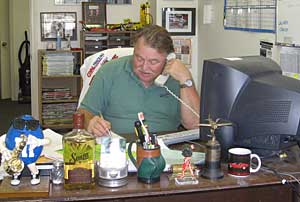Racing Net Source LLC
114 E. Elm St. , Ste. 8O'Fallon, MO 63366-2642
636.272.6301 / fax 636.272.0412

DRAG RACING Online will be published on the 8th of each month and will be updated throughout the month.
DRAG RACING Online owes allegiance to no sanctioning body and will call 'em as we see 'em. We strive for truth,integrity, irreverence and the betterment of drag racing. We have no agenda other than providing the drag racing public with unbiased information and view points they can't get in any other drag racing publication.
EDITORIAL |
|
Editor & Publisher, CEO |
Jeff Burk |
Managing Editor, COO |
Kay Burk |
Editor at Large |
Bret Kepner |
Editor at Large, Emeritus |
Chris Martin |
Bracket Racing Editor |
Jok Nicholson |
Nostalgia Editor |
Jeff Utterback |
Contributing Writers |
Jim Baker, Darr Hawthorne, |
Australian Correspondent |
Jon Van Daal |
European Correspondent |
Ivan Sansom |
Poet Laureate |
Bob Fisher |
Cartoonists |
Jeff DeGrandis Kenny Youngblood |
PHOTOGRAPHY |
|
Senior Photographer |
Ron Lewis |
Contributing Photographers |
|
PRODUCTION |
|
Creative Director/ Webmaster |
Matt Schramel |
Production Assistant |
Clifford Tunnell |
Site Programmer/ IT Consultant |
Adrienne Travis |
ADVERTISING |
|
| Director of Sales | Darr Hawthorne 818-424-6656 |
FINANCIAL |
|
| Accounts Manager, Chief Financial Officer | Casey Araiza |
- Agent 1320
- At the Back Door (caption contest)
- Letter to the Editor (for publication)
- New product press releases

© 2006-2020, Drag Racing Online
and Racing Net Source LLC

It’s About Traction, Skill, and the Inmates Running the Asylum!
 “These crew chiefs have to worry about so many things that need to be right in order for the car to run good, that when you throw something into the mix like the track surface to worry about, it puts undue pressure on everybody on the team.” -- Ron Capps
“These crew chiefs have to worry about so many things that need to be right in order for the car to run good, that when you throw something into the mix like the track surface to worry about, it puts undue pressure on everybody on the team.” -- Ron Capps
Item: This year as in the past several years, my friends who either own tracks or promote races have personally bitched to me about the rising cost of traction compound, the time it takes to prep the track, and the racers bitching about the tracks.
Item: As far as I can determine most professional and sportsman racers don’t really care how much bite the track has as long as both lanes have approximately the same.
Item: Professional fuel coupe driver Ron Capps goes off on the NHRA for poor track conditions.
The NHRA drag racing I’ve watched this year in person and on TV has been abysmal, to say the least. Now I’m referring specifically to the racing on track, not the quality of the TV broadcast or broadcast team or the way NHRA handles putting on a race -- those are conducted in a professional manner. But the racing itself is an entirely different deal. To be blunt, mostly it sucks on a couple of levels.
At the Houston race two weeks ago I watched both the Qualifying on Saturday and the Sunday race broadcast. I was bored with the Saturday show, but that didn’t prepare me for what I and the paid spectators at Houston saw on Sunday!
Of the first 16 pairs of nitro cars in the first round of eliminations exactly two pairs, one in Top Fuel eliminations and one in Funny Car, actually saw both cars race to the finish line. Pro Stock’s first round was slightly better but not much. At any given time one lane was clearly better than the other. That in itself isn’t news. It is common knowledge among racers and fans that the NHRA (and to a lesser extent the IHRA and almost all other sanctioning bodies) have issues making and keeping the traction in both lanes capable of handling the demands of NHRA’s nitro, Pro Stock and Pro Mod cars. It is an issue of track prep and repair after an oil-down. The track and sanctioning bodies spend thousands of dollars and man-hours prior to a national event attempting to make a perfect two-lane race track. Often that time and money is wasted either by an act of weather or an oil-down early in the event.
For a couple of years now I’ve been asking why the management of the different tracks and sanctioning bodies spend so much money and time trying for the perfect, pull-your-shoes-off-at-1200-feet track. It simply doesn’t make sense for the sport, the racers, or the fans or me for track owners and operators to indulge in the futile and often ego-driven mission of supplying the racers with a “perfect traction” track.
It made some sense when the sport of drag racing was trying to capture the attention of the stick and ball press or the casual circle track fan by raising the performance standards of the sport so that it could herald and promote four-second, 300-mph nitro cars, and six-second, 200-mph doorslammers. Now they are trying to slow them down. We are never going to see three-second, 350-mph fuel cars, five-second Pro Stockers or four-second Pro Mods as long as we have rev limiters, nitro percentage limits, spec tires and spec motors. Sanctioning bodies, nervous insurance companies and tracks that are too short will make sure of that. Despite all of this, racers continue to demand perfect tracks and rant when they don’t get them.
In an effort to appease them, track owners and sanctioning bodies continue prepping tracks as if they wanted those performance barriers to be broken and, in my opinion, that contributes to spectators sometimes paying hundreds of dollars for the privilege of sitting on aluminum seats under the blazing sun watching guys working mops, pulling rubber tires up and down the track, spraying traction goo and then running a jet dryer over it. Attention track owners and race promoters: watching that being done is booorrriing!!!!
Just who benefits from the Holy Grail of a perfect track? In my opinion, no one! In fact, my opinion is the sport at every level suffers from the quest for “perfect track” far more than it benefits. I’ve heard promoters say the racers won’t come if the track isn’t up to their standards. That may apply in areas where tracks are competing for racers but that reasoning doesn’t float when applied to national events. My observation is that there isn’t anything the sanctioning bodies can do to keep their racers from attending.
This obsession about track prep has reached preposterous levels. I’ve had track-prep people tell me that the fuel racers want the track prepped differently than the Funny Car and the Pro Stockers need something else. The sportsman and bracket guys at national events are sometimes worse about complaining about lack of traction than the pros. So, the track has to be prepped two or three different ways during a national event? Please, say it ain’t so, Joe!
If you are a Top Fuel, Funny Car, Pro Mod or Pro Stock racer at a national event, the tuner usually checks the track and his weather computer and, if the combination is right, will turn every screw and knob he can and goes for Low ET and Top Speed. This scenario seems especially prevalent when nitro is involved. More often than not, if a pro tuner gets the lane he likes he will put in a “kill” tune-up, and if the car doesn’t blaze the tires or shake them off the car, he and seven of his peers get into the top half of the field, which gets them lane choice.
If you’re a pro tuner in the bottom half, you are probably screwed. You know that you’re in the “bad” lane, but you’re probably going to have to go for the throat or most likely be put on the trailer. The result is what we see more often than anyone likes: One car going down track while the other guy’s hot rod spins and/or shakes the tires, the engine RPM goes up, the fuel pump fills the cylinders and (worst case) turns an engine into a smoking, oil-spewing pile! I’ve even been told by people who should know that too much track prep can contribute to tire failure!
It’s way past time that the sport quit wasting time, money, and effort to suit the racers for no good reason I can ascertain. Perhaps architect Mies van der Rohe was onto something with his “less is more” approach.
I don’t say the track shouldn’t be prepped, just that it should be prepped to a much lower traction co-efficient number. Wouldn’t it be easier and cheaper to make the track lanes a lot less sticky? Wouldn’t repairing a track with lower traction be done a lot faster? Wouldn’t it be easier to keep both lanes nearly equal?
I also think doing this would lead to better racing and more exciting racing. The first big change would be that it would re-rack the classes and put everyone on the same page. Clutch tuning would become even more critical and drivers would have to relearn how to drive a fuel car. Professional drag racing tuners and drivers ought to be able to adapt to racing on a dirt road if they had to. I’ve seen Top Fuel cars race on both sand and dirt!
The second change would be that, even more than today, the tracks would get progressively better as rubber is applied and we could see
speeds and ET’s increase dramatically on Sunday! Yes, at first the speeds and ET’s would drop, but who cares? That’s what the sanctioning bodies, tire manufacturers and the insurance companies evidently want.
And one more thing, doing away with ultimately prepped, no-slip tracks would have to make racing in the .90 classes cheaper and more entertaining. If the traction isn’t there, why would 8.90/9.90 racers be buying 650-750 inch torque monster engines? They would just spin the tires with them if the tracks weren’t perfect. They might even have to run the cars from the start line to the finish line instead of launching and then shutting the motor off for two seconds. Oh, the humanity!
Will backing off of the track prep make racing cheaper or closer? Will it cut down on the number of fires and oil downs? Would it make Top Fuel and Funny Car tires less prone to failure? Who knows for sure. Will it save money and cause less time that spectators have to watch track prep between sessions and put more emphasis on the drivers and tuners ability to adapt? I would like to think so.
